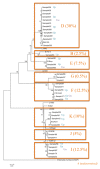Frequency of Chlamydia trachomatis in Ureaplasma-positive healthy women attending their first prenatal visit in a community hospital in Sapporo, Japan
- PMID: 22471518
- PMCID: PMC3342208
- DOI: 10.1186/1471-2334-12-82
Frequency of Chlamydia trachomatis in Ureaplasma-positive healthy women attending their first prenatal visit in a community hospital in Sapporo, Japan
Abstract
Background: Although Chlamydia trachomatis is the most commonly reported pathogen that causes urogenital infection such as urethritis or cervicitis, Ureaplasma parvum and Ureaplasma urealyticum, which are commensals in the genital tract, have also now been recognized as contributors to urogenital infection. However, whether the presence of either U. parvum or U. urealyticum is related to that of C. trachomatis in the urogenital tract remains unknown. We therefore attempted to estimate by PCR the prevalence of C. trachomatis, U. parvum and U. urealyticum in endocervical samples obtained from healthy women attending their first prenatal visit in Sapporo, Japan.
Methods: The samples were taken from 303 apparently healthy women, and the extracted DNAs (n = 280) were used for PCR detection targeting C. trachomatis, U. parvum and U. urealyticum. Statistical analysis of the data was performed by Fisher's exact test.
Results: PCR detection revealed that the prevalence of C. trachomatis, U. parvum and U. urealyticum was 14.3% (40/280), 41.7% (117/280) and 8.9% (25/280), respectively. C. trachomatis ompA genotype D was most frequently identified. Surprisingly, either C. trachomatis or Ureaplasma spp. was detected in almost half of the healthy women. Mixed infection of C. trachomatis with either U. parvum or U. urealyticum was also observed in 9.2% (26/280) of the women. There was a significant association between C. trachomatis and either U. parvum (p = 0.023) or Ureaplasma total (p = 0.013), but not U. urealyticum (p = 0.275).
Conclusion: This study demonstrated that the presence of Ureaplasma had a significant effect on the presence of C. trachomatis in the genital tract of healthy women, suggesting that mixed infection is an important factor in bacterial pathogenesis in the genital tract.
Figures



Similar articles
-
Ureaplasma parvum and Ureaplasma urealyticum detected with the same frequency among women with and without symptoms of urogenital tract infection.Eur J Clin Microbiol Infect Dis. 2015 Jun;34(6):1237-45. doi: 10.1007/s10096-015-2351-8. Epub 2015 Feb 26. Eur J Clin Microbiol Infect Dis. 2015. PMID: 25717022
-
Detection of Mycoplasma genitalium, Mycoplasma hominis, Ureaplasma urealyticum, and Ureaplasma parvum DNAs in urine from asymptomatic healthy young Japanese men.J Infect Chemother. 2006 Oct;12(5):269-71. doi: 10.1007/s10156-006-0462-y. Epub 2006 Nov 6. J Infect Chemother. 2006. PMID: 17109090
-
Molecular investigation of menstrual tissue for the presence of Chlamydia trachomatis, Ureaplasma urealyticum and Mycoplasma hominis collected by women with a history of infertility.J Obstet Gynaecol Res. 2014 Jan;40(1):237-42. doi: 10.1111/jog.12165. Epub 2013 Oct 7. J Obstet Gynaecol Res. 2014. PMID: 24118383
-
Should we be testing for urogenital Mycoplasma hominis, Ureaplasma parvum and Ureaplasma urealyticum in men and women? - a position statement from the European STI Guidelines Editorial Board.J Eur Acad Dermatol Venereol. 2018 Nov;32(11):1845-1851. doi: 10.1111/jdv.15146. Epub 2018 Jul 6. J Eur Acad Dermatol Venereol. 2018. PMID: 29924422 Review.
-
Rare case of Ureaplasma parvum septic arthritis in an immunocompetent patient.BMJ Case Rep. 2020 Sep 8;13(9):e236396. doi: 10.1136/bcr-2020-236396. BMJ Case Rep. 2020. PMID: 32907868 Free PMC article. Review.
Cited by
-
Evaluation of the prevalence of sexually transmitted bacterial pathogens in Northern Cyprus by nucleic acid amplification tests, and investigation of the relationship between these pathogens and cervicitis.Turk J Obstet Gynecol. 2019 Dec;16(4):242-248. doi: 10.4274/tjod.galenos.2019.80269. Epub 2020 Feb 28. Turk J Obstet Gynecol. 2019. PMID: 32231855 Free PMC article.
-
Molecular epidemiology of selected sexually transmitted infections.Int J Mol Epidemiol Genet. 2013 Sep 12;4(3):167-74. eCollection 2013. Int J Mol Epidemiol Genet. 2013. PMID: 24046809 Free PMC article.
-
Presence of Chlamydia trachomatis DNA in the amniotic fluid in women with preterm prelabor rupture of membranes.J Matern Fetal Neonatal Med. 2021 May;34(10):1586-1597. doi: 10.1080/14767058.2019.1640676. Epub 2019 Jul 15. J Matern Fetal Neonatal Med. 2021. PMID: 31272257 Free PMC article.
-
Mycoplasma genitalium and Mycoplasma hominis infection in south Korea during 2018-2020.Iran J Microbiol. 2021 Oct;13(5):602-607. doi: 10.18502/ijm.v13i5.7423. Iran J Microbiol. 2021. PMID: 34900157 Free PMC article.
-
Comparison between culture and a multiplex quantitative real-time polymerase chain reaction assay detecting Ureaplasma urealyticum and U. parvum.PLoS One. 2014 Jul 21;9(7):e102743. doi: 10.1371/journal.pone.0102743. eCollection 2014. PLoS One. 2014. PMID: 25047036 Free PMC article.
References
-
- WHO. Global Prevalence and incidence of Curable Stis. Geneva: World Health Organization; 2001.
-
- WHO. Priority eye diseases. 2008. [WWW document]. URL http://www.who.int/blindness/causes/priority/en/index2.html.
Publication types
MeSH terms
Substances
Associated data
- Actions
- Actions
- Actions
- Actions
- Actions
- Actions
- Actions
- Actions
- Actions
- Actions
- Actions
- Actions
- Actions
- Actions
- Actions
- Actions
- Actions
- Actions
- Actions
- Actions
- Actions
- Actions
- Actions
- Actions
- Actions
- Actions
- Actions
- Actions
- Actions
- Actions
- Actions
- Actions
- Actions
- Actions
LinkOut - more resources
Full Text Sources
Medical
Miscellaneous

